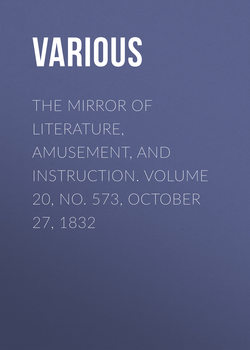The Mirror of Literature, Amusement, and Instruction. Volume 20, No. 573, October 27, 1832

Реклама. ООО «ЛитРес», ИНН: 7719571260.
Отрывок из книги
This picturesque specimen of olden architecture stands upon the Norton Lees estate, on the northern verge of Derbyshire upon the adjacent county of York; about a mile from Sheffield, and eight miles north of Chesterfield, and but a short distance from Bolsover Castle, pictured in No. 566 of The Mirror. "The estate, in the reign of Henry VII., was the property of the family of the Blythes of Norton, two of whom arrived at great honours in the church; one of them, John, being the Bishop of Salisbury, and the other, Geoffrey, Bishop of Lichfield and Coventry."1 The above was the mansion of the family: its picturesqueness is of pleasing character; and our inquiry into the probable age of the structure has naturally enough led us into a few observations upon the early domestic architecture of this country. The subject is, however, too rife with interesting details for the present occasion; so that all we now purpose is by way of reference to the specimen or illustration before us.
The house at Norton Lees has been supposed by some persons to be as old as the reign of Richard II.; but Mr. Rhodes observes, "that it was erected many years after this period can hardly be doubted." Certain features of resemblance assist its appearance of antiquity, as the wooden framework, which is observable in the oldest specimens of house-building in this country. According to Strutt, the Saxons usually built their houses of clay, kept together by wooden frames; shortly after the Norman Conquest plaster was intermixed with timber, and subsequently the basement story was made of stone. The upper apartments were so constructed as to project over the lower, and considerable ornament both in carved wood and plaster was introduced about the doors and windows and roof of the building. Nevertheless, timber, with lath and plaster, and thatch for the roofs, constituted the chief materials in the dwellings of the English from an early period till near the close of the fourteenth century and beginning of the fifteenth, when bricks began to be used in the better sort of houses.2 The mansion before us, as we have seen, is referred to the first-mentioned period. Mr. Rhodes, however, observes, "though composed of stone and wood, it is evident not one of the earliest structures of this description: it is indeed highly probable that it was built in the reign of the Seventh or Eighth Henry, but certainly not sooner. At this period the halls or family mansions of the yeomanry of the country had nearly all the same general character. Previously, but little stone was used in any of them."3; It is true that stone houses are mentioned nearly three centuries and a half before the date of the hall at Norton Lees, as settled by Mr. Rhodes; as we find them belonging to citizens of London in the reign of Henry II.; "and," observes Mr. Hallam, "though not often perhaps regularly hewn stones, yet those scattered over the soil, or dug from flint quarries, bound together with a very strong and durable cement, were employed in the construction of manorial houses, especially in the western counties and other parts where that material is easily procured. Harrison says, that few of the houses of the commonalty, except here and there in the west country towns, were made of stone. This was about 1570. Gradually, even in timber buildings, the intervals of the main beams were occupied by stone walls, or where stone was expensive, by mortar or plaster, intersected by horizontal or diagonal beams, grooved into the principal piers. This mode of building continued for a long time, and is familiar to our eyes in the older streets of the metropolis, and in many parts of the country."4 Harrison, just quoted, says, "the ancient manours and houses of our gentlemen are yet and for the most part of strong timber, in framing whereof our carpenters have been and are worthily preferred before those of like science among all other nations. Howbeit, such as are lately builded are either of brick or hard stone, or of both."
.....
As the sun was the object of adoration, no wonder that mysteries were also performed to the moon, riding in silver splendour through azure space; smiling from her height upon the departed and unseen luminaries which had sunk over the distant hill, the fearful mind would watch the lamp of night as a guardian world, or deity, and in the fervour of gratitude, or under the impulse of fear, would address her as the mediatrix between man and his deity.
The chief times of devotion were at the summer solstice and the winter solstice, (whence the YULE clog), mid-day, or midnight—a zenith being their period. The new and full moon was duly reverenced. On the sixth day, a high officiating Druid gathered mistletoe; a ceremony conducted with great solemnity. It was cut with a golden knife, caught in a white robe, and not allowed to touch the ground. The shadow of this Druidical rite exists in the peculiar privileges of kissing under the mistletoe at Christmas times.
.....